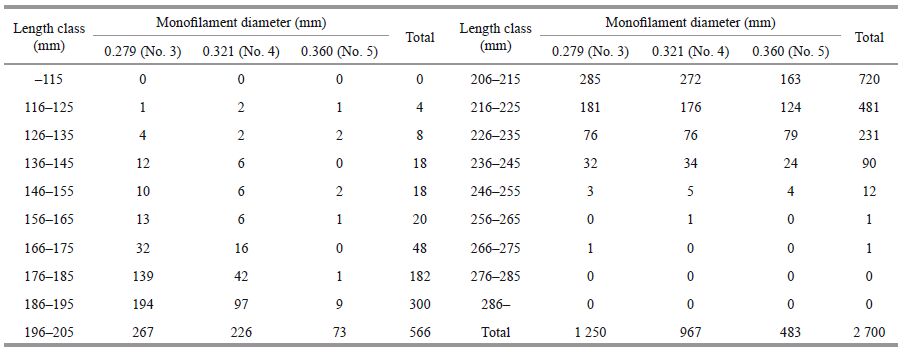Institute of Oceanology, Chinese Academy of Sciences
Article Information
- Seonghun KIM, Jihyun LIM, Kyounghoon LEE, Seongwook PARK
- Effect of twine thickness on size-selectivity of driftnet for the yellow croaker Larimichthys polyactis in southwestern Sea of Korea
- Chinese Journal of Oceanology and Limnology, 34(6): 1199-1208
- http://dx.doi.org/10.1007/s00343-016-5107-0
Article History
- Received Apr. 5, 2015
- accepted for publication Jul. 8, 2015
- accepted in principle Jan. 8, 2017
2 School of Marine Technology, Chonnam National University, Yeosu 59626, Korea
The yellow croaker is one of the (economically) higher-value species inhabiting the southwestern coastal waters of Korea and is traditionally valued as a delicacy. They are caught mainly in the East China Sea and the Yellow Sea (the northern part of the East China Sea between China and Korea, commonly called the West Sea in Korea).
Recently, the stock of the yellow croaker has continually fluctuated, but is showing an overall downward trend. The major fishing ground for the yellow croaker are the Yellow Sea and the East China Sea. Korean inshore driftnet fishing vessels and Chinese gillnet fishing vessels and trawlers are fishing competitively in these sea areas, giving rise to frequent fishing ground accidents. On the one hand, from an ecological perspective, the stock is declining because of excessive catching, whereas the growth and maturation of individuals is becoming more rapid, and the body length of mature individuals is decreasing (Kim et al., 2009). The main fishing methods for catching yellow croakers include driftnets, stow nets, and trawls. Of these methods, the catch using driftnets amounted to 23 432 MT in 2012, accounting for approximately 63.6% of the total yield (MIFFA, 2012).
According to fishery related regulations of Korea for the conservation of fishery resources, driftnets for yellow croakers cannot use a mesh size smaller than 50 mm. For the net twine, monofilament is used, usually with a No. 3 thickness (standard diameter: 0.284 mm). However, in sea areas where the fishing ground's seabed topography is rough or the currents are fast, fishermen may go up from a No. 3 to a No. 4.5(standard diameter: 0.330 mm) instead. Using a twine with a different thickness influences the size composition of the individuals in a catch and changes the size of the catch (Hansen, 1974; Hamley, 1975; Yokota et al., 2001; Kim et al., 2013). In addition, twine thickness has been reported to be a factor affecting selectivity (Fujimori and Tokai, 2001; Yokota et al., 2001 ; Holst et al., 2002). Nevertheless, there has been little research on the effect that changing twine thickness has on catch selectivity.
In this study, we investigated a yellow-croaker driftnet, in which a target fish is usually caught by being wedged or gilled within a mesh, and identified how its characteristics depended on the twine thickness through evaluations of three different sizes of twine. Then, we analyzed the influence of twine thickness on catch selectivity by conducting an onsite sea trial. These results were also intended for use as baseline data for the rational design of yellow croaker driftnet fishing gear and for managing fishery resources.
2 MATERIAL AND METHOD 2.1 Test of physical properties of net twineIn order to identify the physical properties of the twine used in the test fishing gear, the breaking load, elongation, and stiffness were measured. Three thicknesses of twine were used in the test fishing gear. For each thickness, 100 samples with lengths of 1 m were made, and vernier calipers were used for measurement (Mitutoyo, 547-401, Japan). The measured thickness values were then averaged. The denier values were averaged after the 100 samples were weighed. These values were used to convert them to the weight of 9 000-m long twine.
The breaking load and elongation of net twine were tested following the ASTM D 638 testing method, and were measured using a universal materials tester (Instron 3365, USA). We measured the values with a precision of 1/1 000 g every 0.1 s and stored the measured values in a PC for later analysis. In the tensile test, the clamp spacing was 400 mm, and data on the breaking load and elongation values were obtained from twenty cases where the specimen broke in the middle. The stiffness was tested using the Brandt's method (Andres and Garrother, 1964), wherein a sample was prepared by winding the specimen evenly around a 4-cm diameter cylinder and then peeling it. To measure the stiffness, we pressed the sample down using a stiffness measurement apparatus and measured the force applied to the sample when it was compressed to 2.5 cm, as shown in Fig. 1.

|
| Figure 1 Apparatus for measuring stiffness of monofilament samples a. composition of apparatus for stiffness test (a. load cell; b. moving test bed; c. main power; d. motor speed controller; e. amplifier; f. apparatus control and data storage PC); b. stiffness test by using the Brant's method (Andres and Garrother, 1964). |
The load cell used in the measuring device had a maximum capacity of 0.1 N. The measured data were amplified with an amplifier (Sentech-20, Korea) and stored at sampling intervals of 0.1 s for a 15-s period. The test compression speed was 2 mm/s. We produced 20 test samples each for wet and dry conditions. The wet condition was induced by immersing the samples in distilled water for 24 h. The temperature of the laboratory was maintained at 23±2℃, and the relative humidity was maintained at 64±3% while the test was performed.
2.2 Sea trialFor the size-selectivity test of the driftnets for yellow croakers, experimental fishing nets with three different twine thicknesses were manufactured, and an experimental fishing operation was carried out in the coastal sea of Chooja-do, Jeju. The experimental fishing nets were manufactured using a net composition identical to that of the driftnets for the yellow croaker used by the yellow croaker driftnet fishermen in the seas near Chooja-do: a mesh size of 50 mm and net dimensions of 280 vertical meshes × 1 000 horizontal meshes. The float line's buoyancy was 180 g per meter, and the sinking force 225 g per meter. The sinking force of the mesh per unit length is about 130 g and the rope's buoyancy force is insignificant, so the buoyancy force acting on the mesh is about 50 g. Also, because the line connecting the float line and sinker line is fixed to 11 m, it exerts little force on the mesh. The twine thickness and net dimensions of each experimental fishing net are listed in Table 1.
Five panels for each twine thickness were manufactured, and these experimental fishing nets were arranged in the middle of a 175-panel commercial net, so that the vertical alignment would be perfect and no differences in fishing net efficiency would occur. The arrangement of the experimental fishing nets is shown in Fig. 2.

|
| Figure 2 Arrangement of experimental nets for selectivity experiments C*: commercial gear. |
The experimental fishing operation was carried out using a coastal gillnet fishing vessel (Haechang, 9.77 tons) about 20 miles offshore, northwest of Chooja-do, where the fishing depth was from 90 to 110 m. The location of the experimental fishing operation site is shown in Fig. 3.
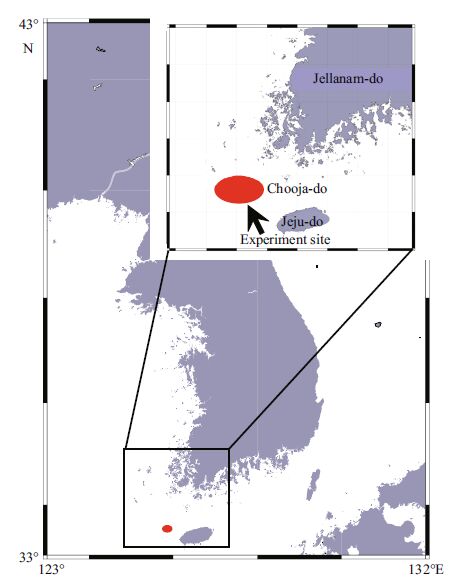
|
| Figure 3 Location of sites for selectivity experiments using drift nets with three different monofilament thicknesses |
The experimental fishing operation was to shoot the net before sunrise and haulit in after it had been soaked for around 5 to 6 h. The catch was sorted according to the three net types with the number of individuals being counted and their weights and lengths being measured. The experimental fishing operation was performed seven times from November to December 2011, and the data from seven catches, after excluding those nets with imbalanced catches due to adverse weather condition and burst nets, were used for analysis of selectivity.
2.3 size-selectivity estimation methodFor the selectivity curve estimation method, we employed Kitahara's method (1968) based on Baranov's geometrical similarity (1914) and the method of Fujimori et al.(1996), which expresses the selectivity curve in terms of a polynomial.
The selectivity is generally the mesh size selectivity, in which the mesh size-dependent body length composition of the catch is analyzed. However, we kept the mesh size constant in order to investigate the selectivity changes according to the twine thickness, and the twine thickness-dependent body length composition of the catch was used for analysis, using Kitahara's method.
The method for estimating Kitahara's selectivity curve is based on the geometric similarity hypothesized by Baranov; this is the hypothesis that if the mesh size increases by a factor of k, the size of the fish in the catch (body length) also increases by a factor of k, as expressed in Eq.1. Kitahara, based on this hypothesis, found the relative body length l / m by normalizing body length l against mesh size m and obtained the selectivity curve s (lj / m i) as follows (Kitahara, 1968):
 (1)
(1)where k is a proportional constant, and cij, the number of fish in the catch per unit of effort, can be written as follows:
 (2)
(2)where Cij is the number of individuals with body length li caught in a net with mesh size mi, and Xi is the catch effort. The term for catch efficiency is denoted by q, which represents the influence of the fishing conditions such as differences in the net structure and soaking time, and di denotes the relative fish stock density of body length li. Taking the logarithms of both sides of Eq.2 yields the following equation:
 (3)
(3)The second term on the right-hand side of Eq.3 is a correction value representing the catch efficiency and stock density. Kitahara's method, like Ishida's method (1962), has the downside that it has no curve equation to represent the selectivity curve. Accordingly, in order to express the selectivity curves related to the mesh size as one master curve, Fujimori et al.(1996) applied the polynomial master curve function in Eq.4 to Kitahara's method.
 (4)
(4)where R = lj / mi. As for the degree of the polynomial, the selectivity curve to be applied is estimated with a second-order polynomialif it is right-left symmetrical or a third-order polynomialif it is right-left asymmetrical. In the case of gill nets, however, there are cases where the individuals caught are not precisely consistent with Baranov's theory, and the cases where the selectivity curve is asymmetrical tend to have higher reliability than those where it is rightleft symmetrical (Kim and Lee, 2002; Park et al., 2003; An et al., 2013). Accordingly, in this study, we derived the selectivity curve equation using a thirdorder polynomial for the selectivity curve. In addition, the relative efficiency q was generally assumed to have a maximum value of 1. In this case, the selectivity curve s (R) can be expressed by the following equation:
 (5)
(5)where Fmax is the maximum value of Eq.4 and can be obtained by differentiation (Kim and Lee, 2002). Each parameter of the function was obtained using the least squares method. To assess the goodness-offit of the model, we obtained an unbiased estimator of the error (ρ).
3 RESULT 3.1 Physical properties of the net twine
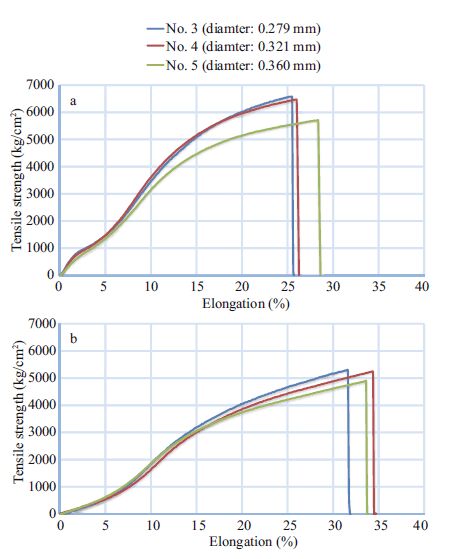
|
| Figure 4 Line strength and elongation curves of three kinds of monofilaments under dry (a) and wet (b) conditions The straight-line breaking strength for each twine thickness was determined for dry and wet conditions and expressed as force per cross-sectional area. No. 3 twine (6 572.5 kg/cm2) showed the highest value of breaking strength under the dry condition, followed by No. 4 twine (6 463.5 kg/cm2) and No. 5 twine (5 705.2 kg/cm2). Just as for the dry condition, the order of breaking strength under the wet condition was No. 3 twine (5 297.6 kg/cm2), No. 4 twine (5 241.5 kg/cm2), and No. 5 twine (5 135.9 kg/cm2), with the values about 19% lower than those under the dry condition. In addition, the elongation of No. 3 under the wet condition showed about 24% more elongation (dry condition 25.5%; wet condition 31.6%), and No. 4 twine and No. 5 twine showed results similar to No. 3 twine. Consequently, it was demonstrated that the strength of polyamide (nylon) twine decreases in water, but its elongation increases. |
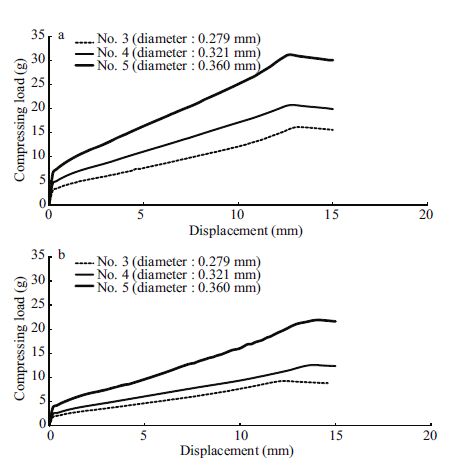
|
| Figure 5 Stiffness values of three monofilaments with different diameters under dry (a) and wet (b) conditions |
The twine thickness was measured ten times for each sample, and the diameters of No. 3, No. 4, and No. 5 twine were shown to be 0.279 mm (Td 692.5), 0.321 mm (Td 918.5), and 0.360 mm (Td 1155.2), respectively.
Stiffness is a factor that influences the catch using a driftnet. A stiffness test apparatus was used to measure the strength required to compress the specimen to a width of 25 mm. The test results for the twine of each thickness used in experimental fishing nets are shown in Fig. 5.
Under the dry condition, the stiffness was 16.18 g for No. 3 twine, 20.72 g for No. 4 twine, and 31.14 g for No. 5 twine, demonstrating that as the thickness increased, the compression force increased, and thus the flexibility decreased. Their stiffness values under the wet condition were 9.28, 12.58, and 21.91 g, respectively. Thus, compared with the dry condition, the force decreased by about 40%, which demonstrated that polyamide (PA), by its nature, absorbs water well, and concurrently increases in flexibility (Kim et al., 2013, 2014).
However, it appeared that the compression force difference between the dry and wet conditions decreased as the thickness increased.
3.2 Sea trialThe sea trial data were collected from seven experimental fishing operations in Nov. and Dec. 2011. However, three trials have been excluded because their data were outliers, and only the data from the remaining four trials were analyzed. The catch ratio and catch per unit effort (CPUE) for the species of fish caught in the experimental fishing operations are listed in Table 2.
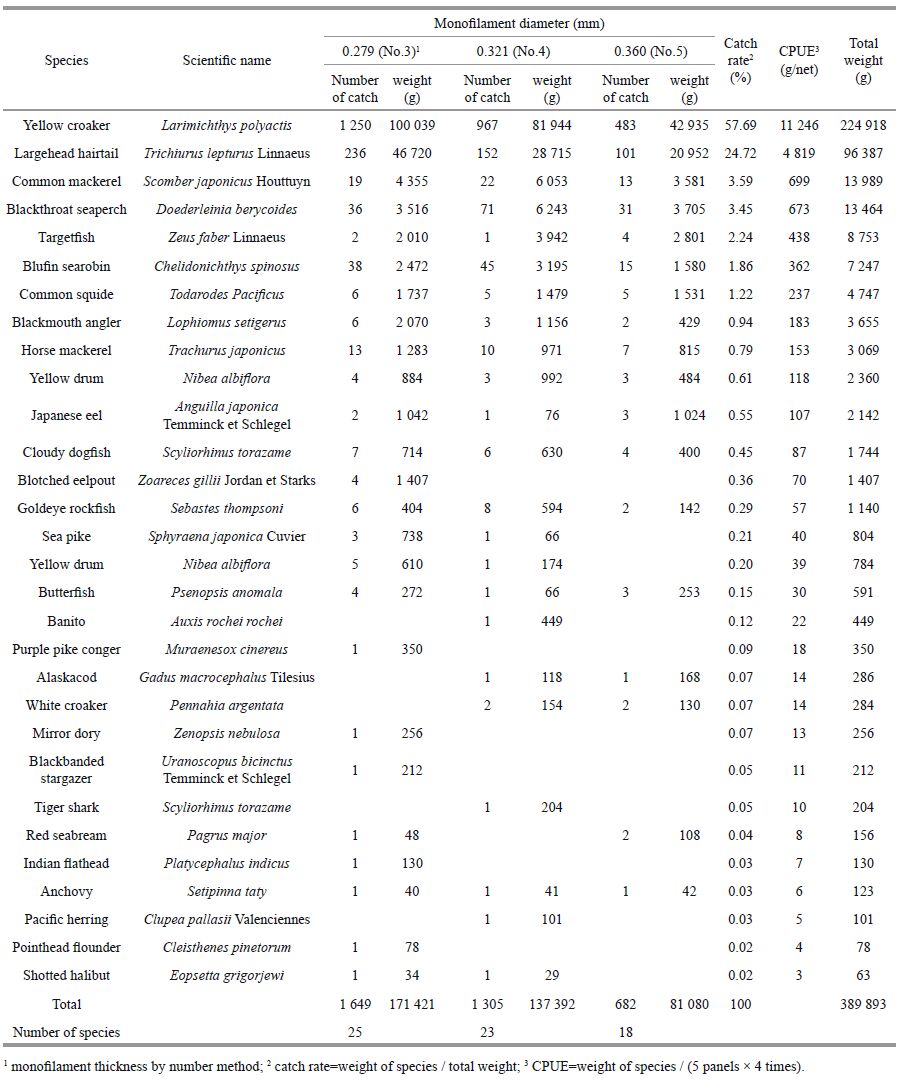
|
The experimental fishing operation yielded the following results. The total number of species caught was 25, and the total number of individuals caught was 3 636(389 893 g). Of these, the main target species, the yellow croaker, weighed in at 224 918 g, or 57.7% of the total catch. The net of No. 3 twine showed a total of 25 species caught, and a total number of 1 649(171 421 g) fish caught. The net of No. 4 twine showed a total of 23 species caught, and, with a total number of 1 305(127 392 g) individuals caught, the catch was 80.1% of that for the net made of No. 3 twine. The net of No. 5 twine showed a total number of 18 species caught, and a total number of 682(81 080 g) individuals caught. In the case of the net made of No. 5 twine, it showed that it was about 47% of the catch of the No. 3 net, demonstrating the tendency for the catch to decrease dramatically as the twine thickness increased. The yellow croaker catches according to twine thickness were 1 250(100 039 g) for the net of No. 3 twine, 967(81 944 g) for the net of No. 4 twine, and 483(42 935 g) for the net of No. 5 twine. Thus, since the case using a net of No. 5 was about 47.3% of the yellow croaker catch for the net of No. 3 twine, it demonstrated that the yellow croaker catch dramatically decreased as the thickness of twine increased. In addition, while there was a large catch of species of fish other than yellow croaker for the No. 3 net, for nets with the thicker No. 4 and No. 5 twine, the number of species of fish caught was smaller.
The distributions of the catches divided by the length class of the main target fish, yellow croaker, are listed for driftnets with different twine thicknesses in Table 3. Figure 6 shows the body length distributions of the caught fish for each net thickness.
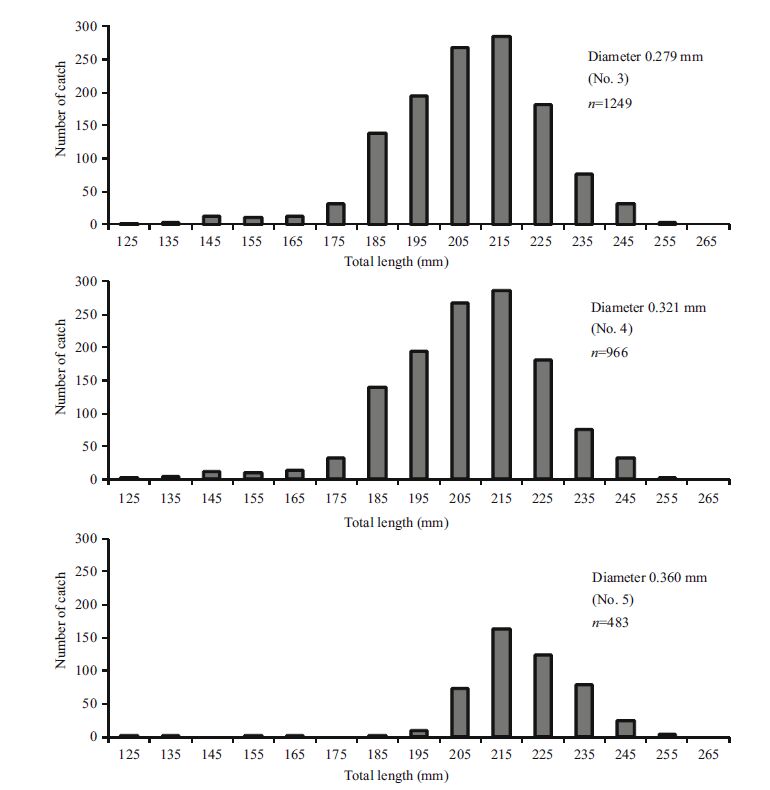
|
| Figure 6 Length distribution of yellow croaker caught by experimental driftnets with three different monofilament thicknesses |
The size-selectivity curves for the driftnets for the yellow croaker with the three twine thicknesses are shown in Fig. 7 based on Kitahara's method, using the catch data from Table 3. The selectivity curves were estimated with a third-order polynomial. The parameters of each curve were estimated using the least squares method, and the function parameters are summarized in Table 4.
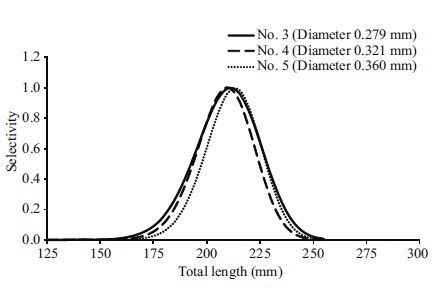
|
| Figure 7 Selectivity curves of each experimental driftnet estimated by Kitahara's method |
The selectivity curves show that, as the twine thickness increases, they tend to shift slightly to the right, and the body length value at the selectivity value of 1 becomes slightly larger. Nevertheless, in the case of the No. 4 net, the body length value that yields the highest selectivity value appears to be slightly smaller than that for the No. 3 net. It is also seen that as the twine becomes thicker, the breadth of the selectivity curve becomes narrower, and in the case of the No. 3 net, which had the best flexibility, the breadth of the selectivity is wider than those for the nets of other thicknesses.
The evaluation criteria for the selectivity, 25%(L25), 50%(L50), and 75%(L75) of the selective length and selection range (SR), are shown in Fig. 8 and listed in Table 5. In the case of the selectivity of 50%, as the thickness of the twine increased, the total length of the individuals caught increased slightly, while the SR, which refers to the degree of selectivity, became narrower, thus enhancing the selectivity. With the SRs for the No. 3, No. 4, and No. 5 net of 15.15, 13.00, and 12.60, respectively, the value for the No. 3 net, which had the highest flexibility, was 1.2 times that of the No. 5 net, demonstrating that the total length range of the yellow croakers in the catch was broader.
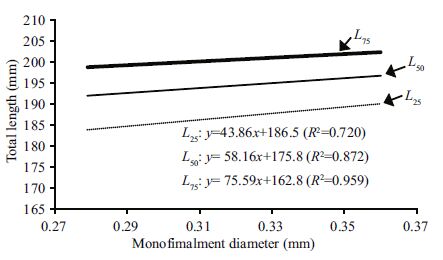
|
| Figure 8 Relationship between monofilament thickness and total length for each selected length of yellow croaker driftnet |
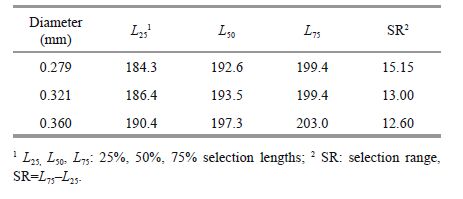
|
The factors that directly influence the size of a catch with a driftnet include the mesh size, hanging ratio, and twine thickness. Of these factors, many studies have been conducted on the hanging ratio and mesh size, and there has also been intensive research on mesh size selectivity, fishing performance, etc. However, there has been a lack of research on the twine thickness and size selectivity, which is related to the size of the individuals in a catch.
Hamley (1975) suggested that twine thickness, which influences net visibility, stretchability, and flexibility, affects a gill net catch. Hansen (1974) demonstrated that a thinner twine caught fish with a longer body length in two species in an experiment using two twine diameters.
In addition, Yokota et al.(2001) reported that the size of the fish captured decreases as the twine thickness decreases, and Turunen (1996) and Hovgård (1996) reported that the size of the twine thickness and the mesh size influence the catch size. In this study, the individuals captured with the net of No. 3, which was made of the thinnest twine, were shown to have an overall broader total length range and to be smaller than those captured with the No. 4 and No. 5 nets. In addition, in the cases of the No. 4 and No. 5 nets, the proportion of large individuals caught was smaller than that for the No. 3 net. Accordingly, although the total length that showed the maximum selectivity value was found for the net made of the thickest No. 5 twine, it cannot be said that individuals caught with this twine were overall larger than those caught with the nets made of thinner twine; it can only be inferred that the body length range was narrower, and thus a more selective catch was possible.
Moreover, in this study, in order to assess the effect of twine thickness on catch size and selectivity, the selectivity was analyzed for a consistent mesh size of 50 mm with Kitahara's method. However, in reality, as the twine becomes thicker, the mesh size changes, and there are reports that this can affect the selectivity (Lowry and Robertson, 1996; Yokota et al., 2001). In fact, in the case of the experimental nets used in this study, with mesh sizes of 49.48±0.17 mm for the No. 3 net and 48.93±0.32 for the No. 4 net, the mesh size for the No. 5 net, with a gauge of 48.33±0.31 mm, was 1.15 mm smaller than that for the No. 3 net. Baranov's hypothesis claims that the mesh size and body length of the caught individuals are proportional, so when the mesh size became smaller in this study, the body length of the catch was expected to decrease. In reality, however, it was found that the catch ratio of small fish decreased with an increasing twine thickness due to the effect of flexibility.
Based on the experimental results, it can be inferred that using a different twine thickness according to the conditions of the fishing ground can be conducive to preventing damage to the fishing nets, but on the other hand, it can have an effect on the size of the individuals captured. Therefore, when manufacturing fishing nets, designs will have to reflect complex factors such as the catch and fishing ground conditions.
5 CONCLUSIONIn order to determine the effect of the twine thickness on the size-selectivity of the driftnet used for yellow croakers, we manufactured driftnets with three different thicknesses (monofilament diameters of 0.279 mm (number's method; No. 3), 0.321 mm (No. 4), and 0.360 mm (No. 5)) and conducted a sizeselectivity test on yellow croakers in the seas around Chooja-do, Jeju.
The main conclusions drawn from this study can be summarized as follows:
1) The physical properties of the net twines
The thinnest net made of No. 3 twine, had the strongest breaking strength per cross-section area, along with good elongation and excellent flexibility. The thickest net of No. 5 twine, had the lowest flexibility.
2) The fishing performance according to twine thickness
The yellow croaker catches according to twine thickness were dramatically decreased as the thickness increased. The catch using the net made from the No. 5 twine was about 47.3% of the yellow croaker catch using the net made of No. 3 twine.
3) The twine thickness on the size-selectivity
In terms of the selectivity, the net of No. 3 twine showed the broadest selection range and, thus, a relatively low selectivity compared to the other nets, while the less flexible net of No. 5 twine showed the narrowest selectivity range and thus highest selectivity.
In addition, it was found that a thicker twine resulted in a smaller haul of small fish. Therefore, it can be inferred that the thickness of the twine affects the size of the catch and selectivity, and thus the size composition of the catch as well.
6 ACKNOWLEDGEMENTWe would like to thank Mr. Woo-Suk Oh for his help with operating field experiments.
| An H C, Bae J H, Kim S, 2013. Study on the size selectivity of a gillnet for Pacific herring (Clupea pallasii) in the eastern sea of Korea. Journal of the Korean Society of Fisheries Technology, 49 (4) : 360 –367. Doi: 10.3796/KSFT.2013.49.4.360 |
| Andres V B, Garrother P J G, 1964. Test Methods for Fishing Materials:Modern Fishing Gear of the World. Fishing News Books Ltd Press, New York49. |
| Baranov F I, 1914. The capture of fish by gillnets. Mater. Poznoniyu Russ. Rybolov, 3 : 56 –99. |
| Fujimori Y, Tokai T, Hiyama S, et al, 1996. Selectivity and gear efficiency of trammel nets for kuruma prawn (Penaeus japonicus). Fisheries Research, 26 (1-2) : 113 –124. Doi: 10.1016/0165-7836(95)00392-4 |
| Fujimori Y, Tokai T, 2001. Estimation of gillnet selectivity curve by maximum likelihood method. Fisheries Science, 67 (4) : 644 –654. Doi: 10.1046/j.1444-2906.2001.00301.x |
| Hamley J M, 1975. Review of gillnet selectivity. Journal of the Fisheries Research Board of Canada, 32 (11) : 1 943 –1 969. Doi: 10.1139/f75-233 |
| Hansen R G, 1974. Effect of different filament diameters on the selective action of monofilament gill nets. Transactions of the American Fisheries Society, 103 (2) : 386 –387. Doi: 10.1577/1548-8659(1974)103<386:EODFDO>2.0.CO;2 |
| Holst R, Wileman D, Madsen N, 2002. The effect of twine thickness on the size selectivity and fishing power of Baltic cod gill nets. Fisheries Research, 56 (3) : 303 –312. Doi: 10.1016/S0165-7836(01)00328-9 |
| Hovgård H, 1996. Effect of twine diameter on fishing power of experimental gill nets used in Greenland waters. Canadian Journal of Fisheries and Aquatic Sciences, 53 (5) : 1 014 –1 017. Doi: 10.1139/f96-023 |
| Kim S H, Lee J H, 2002. Mesh selectivity in trammel net for flat fish. Journal of the Korean Society of Fisheries Technology, 38 (2) : 91 –100. Doi: 10.3796/KSFT.2002.38.2.091 |
| Kim S H, Park S W, Bae J H, et al, 2009. Mesh selectivity of drift gill net for yellow croaker, Larimichthys polyactis, in the coastal sea of gageo-do. Korean Journal of Fisheries and Aquatic Sciences, 42 (5) : 518 –522. Doi: 10.5657/kfas.2009.42.5.518 |
| Kim S H, Park S W, Lee K, et al, 2013. Characteristics on the fishing performance of a drift net for yellow croaker(Larimichthys polyactis) in accordance with the thickness of a net twine. Journal of the Korean Society of Fisheries Technology, 49 (3) : 218 –226. Doi: 10.3796/KSFT.2012.49.3.218 |
| Kim S H, Park S, Lee K, 2014. Fishing performance of an octopus minor net pot made of biodegradable twines. Turkish Journal of Fisheries and Aquatic Sciences, 14 : 21 –30. Doi: 10.4194/1303-2712-v14_1_03 |
| Kitahara T, 1968. On sweeping trammel net (Kogisasiami) fishery along coast of the San'in district-III, mesh selectivity curve of sweeping trammel net for Branquillos. Bull. Japan Soc. Fish. Tech., 34 : 759 –763. Doi: 10.2331/suisan.34.759 |
| Lowry N, Robertson J H B, 1996. The effect of twine thickness on cod-end selectivity of trawls for haddock in the North Sea. Fisheries Research, 26 (3-4) : 353 –363. Doi: 10.1016/0165-7836(95)00418-1 |
| MIFAFF. 2012. Annual report on the agricultural & fisheries, farming & fishing village and food industry. Ministry for Food, Agriculture, Forestry and Fisheries (MIFAFF). (in Korean) |
| Park C D, An H C, Cho S K, et al, 2003. Size selectivity of gill net for male snow crab, Chionoecetes opilio. Journal of the Korean Society of Fisheries Technology, 39 (2) : 143 –151. Doi: 10.3796/KSFT.2003.39.2.143 |
| Turunen T, 1996. The effects of twine thickness on the catchability of gillnets for pikeperch (Stizostedion lucioperca (L. )). Annales Zoologici Fennici, 33 (3-4) : 621 –625. |
| Yokota K, Fujimori Y, Shiode D, et al, 2001. Effect of thin twine on gill net size-selectivity analyzed with the direct estimation method. Fisheries Science, 67 (5) : 851 –856. Doi: 10.1046/j.1444-2906.2001.00332.x |
 2016, Vol. 34
2016, Vol. 34




